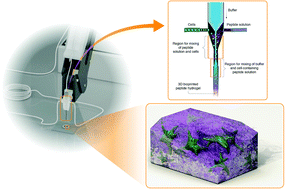
Self-assembling tetrameric peptides allow in situ3D bioprinting under physiological conditions
S. Rauf, H.H. Susapto, K. Kahin, S. Alshehri, S. Abdelrahman, J.H. Lam, S. Asad, S. Jadhav, D. Sundaramurthi, X. Gao, C.A.E. Hauser
Journal of Materials Chemistry B, Volume 9, Issue 4, 2021, Pages 1069-1081We have developed an in situ bioprinting method that allows the printing of cells under true physiological conditions by applying self-assembling ultrashort peptides as bioinks. This method avoids cell stressing methods, such as UV-treatment, chemical crosslinking and viscous bioink printing methods. We further demonstrate that different nanomaterials can easily be synthesized or incorporated in the 3D bioprinted peptide scaffolds which opens up the possibility of functionalized 3D scaffolds.


"KAUST shall be a beacon for peace, hope and reconciliation, and shall serve the people of the Kingdom and the world."
King Abdullah bin Abdulaziz Al Saud, 1924 – 2015
Thuwal 23955-6900, Kingdom of Saudi Arabia
Al-Haytham Building (Bldg. 2)
© King Abdullah University of Science and Technology. All rights reserved